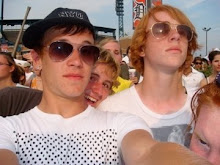 I last read a manga in eighth grade, if memory serves me right. When the manga book happened a decade ago, I got right onboard, but I ultimately couldn't buy into the differences in storytelling between Japanese (and sometimes Korean) tales and the American books I grew up with. I'm never sure if the difference is in translation or the culture itself, but some things never click with me, but I'll get to that in a little bit.
I last read a manga in eighth grade, if memory serves me right. When the manga book happened a decade ago, I got right onboard, but I ultimately couldn't buy into the differences in storytelling between Japanese (and sometimes Korean) tales and the American books I grew up with. I'm never sure if the difference is in translation or the culture itself, but some things never click with me, but I'll get to that in a little bit.First, some context that shows how fundamentally different manga really is from American comics. Firstly, manga is a huge, if declining, business in Japan. Since Japan is a commuter culture, the need for quick entertainment is strong. To put it into perspective, the sales for manga on cell phones alone trumped the sales for comics in America last year. This is partially because there are manga aimed at young children all the way through to stay-at-home moms, but another large reason for this is the disposable format and cheapness of manga. Manga magazines, such as Weekly Shonen Jump (where Death Note first appeared in serialized format), are usually the sizes of phone books, feature only a few ad pages, and are printed on very cheap paper. They come out weekly and tend to cost the equivalent of US $4.00. American comics, on the other hand, ship monthly on nice paper and cost between $2.99 and $3.99 (sometimes more) for 22 pages of story content with 10 pages of ads. Manga readers are frequently polled about what stories they enjoy and features are swapped in and out accordingly, with the popular ones being collected into bound volumes that sell for more money.

Because of the weekly printing schedule, most mangaka (manga creators) are aided by a team of uncredited assistants, many of whom are apprentice mangaka. In many cases, the well known artist lays out panels and draws figures, and little else. Someone else is in charge of backgrounds, lettering, inking, etc. This is not wholly dissimilar to American comics; big name artists provide the pencils, and workhorse creators come in to ink, color, and letter over those pencils. The biggest difference is that those inkers and colorists and letterers are always credited in today's world, and have been for quite some time. The notion of having uncredited artists providing backgrounds or figure work would get an American creator excised by fans and publishers, and assists from other artists are almost always done on different pages and credited as such. As a reader and a hopeful creator, I find the idea of uncredited work distasteful and insulting to the people putting in the long hours to insure the book comes out on time, but this is ingrained in the manga industry. In this book, I found the art capable, but nothing extraordinary. I enjoyed the Shinigami designs, but their world was so muddled in shadow that I was left wanting. In some cases, the backgrounds seemed to be computer-filtered photographs or tracing work, which did nothing to win me over.

With all of that aside, Death Note still wasn't for me. Shonen is manga aimed at teen boys, a category that I don't quite fit into. While I read many slam-bang superhero books, the titles that I tend to enjoy most have heavy character moments, serious drama, well-explored concepts, and sufficient build-up. I am intrigued by Death Note's central premise, and I enjoy Ryuk as a character and as a cool visual, but there is much too little story development for me. I can't fault the series necessarily; if it moved at the pace I would have enjoyed, it surely would have bored the teen readers and been cancelled long before it finished. Within one chapter, Light finds a death note, meets a god of death, and starts his massive quest to rid the world of evil and rule over his utopia. I just can't get into a story that takes place in the "real world" where a teen boy is more brilliant than the entire police force and unfazed by meeting a GOD OF DEATH. The introduction of L. as a young man who inexplicably gets free reign over global task forces only made matters worse. The suspension of disbelief fell through, but it might have worked much better for me when I was a lot younger.
 I don't mean any of this as an insult to the format, as I still believe that I will find manga that I enjoy regardless of production or publishing differences. I enjoyed Death Note for what it is, but that magical manga that clicks with me probably won't be shonen.
I don't mean any of this as an insult to the format, as I still believe that I will find manga that I enjoy regardless of production or publishing differences. I enjoyed Death Note for what it is, but that magical manga that clicks with me probably won't be shonen.

No comments:
Post a Comment